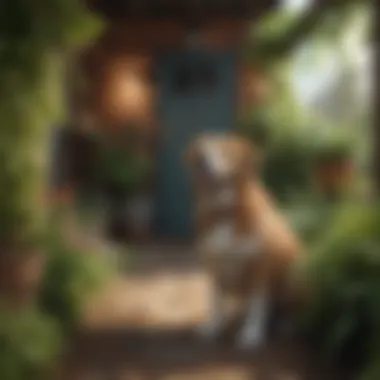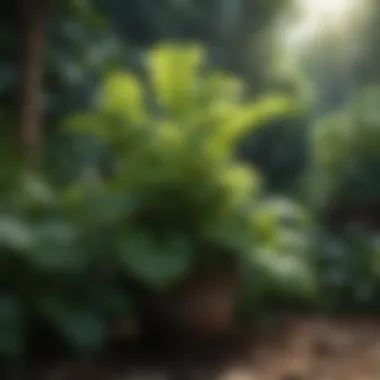Understanding Poisonous Yard Plants for Dogs


Intro
Creating a pleasant outdoor space is a common goal for many homeowners. However, for those with dogs, it is crucial to recognize potential hazards hiding among the plants in the garden. Certain flora can pose serious risks to canine health, making awareness, identification, and prevention essential for pet owners. This article aims to uncover these threats to dogs, enabling owners to cultivate a beautiful garden while safeguarding their furry companions.
Common Poisonous Plants
Gardens can hide a variety of toxic plants, some of which are not immediately recognizable. Understanding which plants can cause harm is the first step toward prevention. Some well-known poisonous plants include:
- Azalea: Ingestion can lead to vomiting and diarrhea.
- Foxglove: Contains toxins affecting the heart, which can be fatal.
- Lily of the Valley: Symptoms can include nausea and severe heart issues.
- Oleander: Extremely toxic, even small amounts can be deadly.
These plants can have detrimental effects on dogs if ingested. Understanding what each species can do helps in being proactive.
Symptoms of Poisoning
Recognizing symptoms of plant poisoning is crucial for timely action. Common indicators include:
- Vomiting
- Diarrhea
- Excessive drooling
- Lethargy
- Seizures
These signs warrant immediate veterinary consultation. Understanding these symptoms can assist owners in acting quickly when harm occurs.
Prevention Strategies
Creating a safe garden environment requires some planning. Here are some prevention strategies for dog owners:
- Research Plants: Before introducing new plants, check if they are toxic.
- Create Boundaries: Designate areas in the yard that dogs cannot access.
- Educate Family: Make sure all family members understand which plants to avoid.
- Use Labels: Clearly label plants in your garden, noting which are safe and which are not.
These steps may help foster a dog-friendly space.
Identifying Toxic Plants
Identification of plants is vital. Here are strategies to help:
- Visual Reference: Utilize online resources or books to identify plants accurately.
- Ask Experts: Consult a local nursery or garden center for plant verification.
- Community Knowledge: Engage with online forums such as Reddit or Facebook groups focused on gardening and pet safety.
Gathering information from a variety of sources aids in accuracy.
Closure
Understanding poisonous yard plants is a necessary component of responsible dog ownership. By identifying harmful plants, recognizing poisoning symptoms, and implementing prevention strategies, pet owners can create a safer environment. Knowledge and vigilance are key elements in ensuring that both gardens flourish and pets remain healthy.
Prolusion to Poisonous Plants
Understanding poisonous plants is crucial for maintaining a safe environment, especially for dog owners. Many people enjoy gardening, but not all plant choices are safe for pets. This section highlights the specific challenges and considerations that arise when dogs and potentially toxic plants share the same space.
Definition of Poisonous Plants
Poisonous plants are species that contain toxic substances capable of harming animals or humans. These plants may produce toxins in their leaves, flowers, or seeds. For dogs, ingestion can lead to serious health complications. Some common examples of poisonous plants include the Sago Palm and Lilies, which are prevalent in many gardens. It is vital for pet owners to be aware not just of the plants they have, but also how these plants can affect their pets’ health.
Significance for Dog Owners
The significance of understanding poisonous plants cannot be understated. Dog owners must recognize the potential risks posed by their garden choices. It involves knowing which plants to avoid and what symptoms might arise if a dog consumes any part of these plants.
- Knowledge about poisonous plants protects dogs from accidental poisoning.
- It empowers owners to create a safer living space for their furry companions.
- Awareness of toxicity helps in identifying symptoms promptly, allowing for timely veterinary intervention.


"A proactive approach is important for ensuring pets remain safe while enjoying the beauty of the outdoors."
In summary, the significance lie in informed choices. Thus, every dog owner should prioritize learning about the poisonous plants that may exist within their gardens.
Common Poisonous Plants in Gardens
The presence of certain plants in gardens can be hazardous for dogs. Understanding which plants are toxic is essential for dog owners who aim to create a safe environment for their pets. The importance of knowing common poisonous plants lies in prevention. Many times, pet owners may not even be aware that a common plant in their yard poses a risk. Exposure to these plants can lead to serious health issues, which is why awareness is crucial.
By recognizing and addressing potential dangers, dog owners can avoid unnecessary vet visits and ensure the well-being of their pets. Additionally, safe gardening practices can still uphold the aesthetic appeal of a garden while prioritizing animal health. Below are some common poisonous plants that should be understood by every responsible dog owner.
Lilies
Lilies are popular ornamental plants, yet they can be extremely toxic to dogs. Ingestion of even small amounts can lead to significant health issues. Symptoms of lily poisoning in dogs include vomiting, diarrhea, and lethargy. Certain types of lilies, like the Easter lily, are particularly harmful. If a dog has ingested any part of this plant, immediate veterinary attention is recommended. The toxin affects gastrointestinal and renal systems, which can complicate treatment if not handled swiftly.
Azaleas
Azaleas are commonly found in many gardens. While they are visually appealing, they contain substances called grayanotoxins, which are toxic to dogs. Symptoms resulting from azalea ingestion can range from mild to severe. Some signs include drooling, vomiting, and in more serious cases, can lead to cardiac issues. It is important for dog owners to be vigilant and monitor their pets after any potential exposure to this plant. Regular checks of the garden can help mitigate risks associated with these beautiful yet dangerous blooms.
Sago Palms
Sago palms are often found in the most appealing landscape designs. However, they represent a serious risk to canine health. All parts of the sago palm are poisonous, with the seeds being the most toxic. Consumption can result in severe liver failure and even death. Signs of sago palm poisoning include vomiting, diarrhea, abdominal pain, and lethargy. Quick veterinary intervention is crucial in such cases, as the poisoning can escalate rapidly. Owners should consider alternative landscaping options to avoid this dangerous plant entirely.
Foxglove
Foxglove is an elegant plant, but it poses significant hazards to dogs if ingested. The plant contains compounds called cardiac glycosides which can affect the heart. Symptoms of foxglove poisoning may include irregular heartbeats, nausea, or even collapse in severe cases. Given its toxicity, dog owners should think carefully about whether to include this plant in their gardens. Identification of potential hazards is the first step towards protecting pets from unnecessary risks.
Understanding the implications of having these plants in gardens is critical for dog owners. By gaining knowledge about the toxicity of specific plants, responsible decisions can be made regarding garden design. The beautiful scenery should not come at the cost of a pet's health.
Symptoms of Plant Poisoning in Dogs
Understanding the symptoms of plant poisoning in dogs is essential for any owner who wants to protect their pet. Dogs are known to explore their environment with curiosity, often tasting and chewing on plants. Awareness of the potential signs of poisoning can be the difference between life and death. Quick recognition of symptoms allows for timely intervention, safeguarding the health and well-being of your dog.
By learning the common indicators of poisoning, dog owners can respond promptly. This knowledge fosters a sense of responsibility towards one’s pet while cultivating an informed approach to gardening. In this section, we will examine three major categories of symptoms: gastrointestinal distress, neurological symptoms, and cardiovascular issues. These categories will provide insight into how the body reacts to toxic plant exposure.
Gastrointestinal Distress
Gastrointestinal symptoms are often the first signs that indicate a dog may have ingested a poisonous plant. Dog owners should be vigilant for the following signs:
- Vomiting
- Diarrhea
- Abdominal pain
- Loss of appetite
When a dog ingests a toxic plant, its body reacts by trying to expel the harmful substance. Vomiting and diarrhea serve as mechanisms to eliminate the toxin. Abdominal pain can arise from inflammation or irritation caused by the toxin. Monitoring for these symptoms provides critical insight into the dog’s condition.
If you notice these signs, do not wait. Contact a veterinarian immediately. Early treatment often increases the chances of recovery and minimizes complications.
Neurological Symptoms
In cases of severe poisoning, dogs may also exhibit neurological symptoms. These can range from mild to severe, depending on the plant involved and the amount ingested. Common neurological symptoms include:
- Disorientation
- Seizures
- Increased sensitivity to stimuli
- Coordination problems
These symptoms signify that the toxins are affecting the nervous system. Disorientation and coordination issues can hinder a dog’s ability to move or interact normally, making it appear confused. Seizures are serious symptoms requiring immediate veterinary care. If you observe any of these signs, prompt action is necessary to reduce the risk of long-term effects.
Cardiovascular Issues


In some cases, plant poisoning can lead to cardiovascular problems. Symptoms may include:
- Rapid heart rate
- Weak pulse
- Shortness of breath
- Fainting or collapsing
These symptoms are particularly alarming as they indicate that the heart and circulatory system are under distress. The seriousness of cardiovascular symptoms makes it crucial for dog owners to be alert. If any of these symptoms are present, it is vital to seek emergency veterinary care without delay.
Important: Always store emergency contact numbers for your veterinarian and poison control nearby, as quick access to help is critical in case of poisoning.
Identifying Toxic Plants
Identifying toxic plants is essential for any dog owner who wants to maintain a safe environment for their pets. Knowledge about these plants helps owners to make informed decisions while gardening or landscaping. Familiarity with specific species and their characteristics can prevent accidental poisoning.
Visual Characteristics
Visual characteristics of plants allow dog owners to identify potential hazards. Many poisonous plants have distinct features that set them apart from non-toxic varieties. For example, the distinctive funnel-shaped flowers of the Foxglove can be easily noted, while the vibrant colors of Azaleas present a beautiful yet dangerous temptation for dogs. Paying attention to leaf shapes, flower forms, and color patterns can aid in the identification process. Additionally, many toxic plants have particular textures or growth habits, such as waxy leaves or thorny stems, which make them easily recognizable.
Growth Patterns
Understanding growth patterns can also be crucial when identifying toxic plants. Some plants are perennial, regrowing each year, while others are annual and may die off after one season. For example, Sago Palms are slow-growing and can live for a long time, making their presence persistent in gardens. Their growth habit may lead unwary owners to overlook the associated risks over time. Observing the life cycle of these plants helps homeowners recognize which ones are potentially harmful, especially if they are known to sprout new growth in warmer months.
Seasonal Variations
Finally, seasonal variations in plant traits must be recognized. Certain plants may appear harmless during specific seasons, only to reveal poisonous characteristics when they bloom or fruit. For instance, Lilies can be confused with non-toxic species when not in bloom. However, during the flowering period, their vibrant colors become evident and highlight their danger to canines. Understanding how plants change throughout the seasons enables homeowners to remain vigilant at all times. By paying attention to these variations, one can better ensure the safety of their pets.
"Being aware of plant characteristics can significantly reduce the risk of poisoning in dogs."
In summary, the steps for identifying toxic plants involve learning about their visual traits, understanding their growth patterns, and monitoring seasonal changes. This knowledge is fundamental in creating a safe haven for dogs in yards filled with plants.
Preventing Exposure to Poisonous Plants
Preventing exposure to poisonous plants is vital for the safety and health of pets, particularly dogs. This ensures that their playful and curious nature does not lead to harmful encounters with toxic flora. The significance of this section lies in its dual approach: offering practical guidance to dog owners while advocating for an awareness of the dangers that specific plants pose in the domestic landscape. The focus will be on designing safe environments, fostering preventative behaviors, and maintaining a high level of awareness. These elements provide peace of mind for pet owners and help avoid the distress caused by potential poisoning incidents.
Creating a Safe Garden Layout
A well-designed garden layout plays a crucial role in preventing access to harmful plants. Strategically place non-toxic plants in areas where dogs frequently roam. Consider using barriers such as fences or hedges to segregate toxic plants. Use mulch or decorative stones around safe plant beds. This discourages dogs from digging or chewing on plants. Additionally, a well-maintained garden allows for easier monitoring of both the plants and the pets. Be mindful of ornamental grasses that might also be enticing for dogs to nibble on, ensuring all plant choices are compatible with a dog-friendly space.
Dog Training Tips
Training dogs on what to avoid can reinforce safety in the garden. Commands such as "leave it" can be immensely helpful in steering clear from toxic plants. Consistent reinforcement through positive rewards will encourage good behavior. Take time to introduce dogs to the garden environment. This helps them learn boundaries and recognize specific areas that are harmful. It is recommended to supervise dogs while they explore new areas, allowing for immediate correction if inappropriate behavior occurs. Involving the pet in training creates a stronger bond and better communication with the owner.
Labeling and Awareness
Clear labeling of plants contributes significantly to awareness. Marking toxic plants with noticeable tags can help in identifying potential dangers. Family members and guests should all be informed about which plants are safe and which are not. This shared knowledge builds a safer environment for dogs. Maintaining an index of plants in your garden, with details on their toxicity, is also beneficial. Regularly educate oneself about new plant varieties introduced in local nurseries to stay informed.
Awareness is the first step in preventing poisoning. Knowledge can save lives.
What to Do in Case of Poisoning
Understanding the steps to take in case of poisoning is crucial for any dog owner. Quick action can often make a significant difference in outcomes when a pet consumes a toxic plant. Knowing how to respond can save your dog’s life and limit the possible long-term effects of poisoning.
Recognizing Urgent Symptoms
It is essential to be aware of the signs that may indicate your dog has ingested a poisonous plant. Dogs can vary in their reactions based on the type and amount of toxin consumed, but some common urgent symptoms include:


- Vomiting or diarrhea
- Excessive drooling
- Difficulty breathing
- Seizures or tremors
- Unresponsiveness or lethargy
- Increased heart rate
If one or more of these symptoms arise shortly after exposure to a plant, this requires immediate attention. Observing your dog’s behavior and note any unusual changes is critical. Rapid recognition of these signs can help in seeking timely veterinary care.
"The faster you act, the better the chances for recovery. Time is of the essence when dealing with plant poisoning."
Immediate First Aid Steps
When faced with a suspected poisoning incident, follow these immediate first aid steps:
- Stay calm: It is vital to keep a clear head to make decisions.
- Remove the source: Get your dog away from the plant and any remaining plant material.
- Check mouth: If safe to do so, check your dog’s mouth for any remaining leaves or seeds. If present and reachable, remove them carefully.
- Do not induce vomiting: Inducing vomiting can sometimes cause more harm than good. Always consult with a veterinarian before attempting this.
- Call your veterinarian: Provide details about the incident, including the type of plant and symptoms observed. They will guide you on the next steps.
Taking these immediate actions could be life-saving. Always be prepared by saving your veterinarian's number or having an emergency clinic's contact on hand.
Veterinary Care and Treatment
After initial first aid, veterinary care becomes necessary. Once you arrive at the clinic, the veterinarian will assess your pet's condition and might carry out tests to determine the type of poison.
Treatment may involve:
- Activated charcoal: Administered to absorb toxins if ingestion was recent.
- Intravenous fluids: To keep your dog hydrated and to flush out toxins.
- Medications: Depending on the symptoms, medications may help manage distressing effects.
It is important to have as much information as possible ready for the veterinarian. This includes details about the plant, quantity ingested, and any symptoms observed. This will foster accurate diagnosis and treatment.
By being proactive and knowledgeable about the steps to take in case of poisoning, you can significantly reduce risk to your dog. Connecting with the local vet or a dog poison hotline can also provide guidance tailored to your specific region.
Safe Alternatives to Poisonous Plants
The selection of plants for a garden is critical, especially for dog owners. Adopting safe alternatives to poisonous plants is a proactive measure to ensure the wellbeing of pets while still enjoying a vibrant landscape. The right choices can eliminate the risk of toxicity while providing a variety of colors and textures in your outdoor space.
Non-Toxic Plant Varieties
When choosing plants, homeowners should consider non-toxic varieties that thrive in local climates. Species such as Marigolds, Basil, and Snapdragons are often both safe and visually appealing. These plants can enhance your garden without the threat to dog health. Another excellent choice is the Areca Palm, known for its aesthetic appeal and non-toxic nature. Not only do these plants beautify the environment, their presence can help maintain a safe space for dogs to roam and play. Here are few notable options:
- Pansies: Colorful and edible, perfect for flower beds.
- Zinnias: Bright blooms that attract pollinators but are safe for pets.
- Bamboo Palm: A versatile indoor or outdoor option that is non-toxic.
Homeopathy and Herbal Remedies
Homeopathy and herbal remedies offer alternative solutions that align with natural gardening philosophies. They work as a preventive measure against using conventional, possibly toxic garden treatments. Some common herbs like Chamomile or Calendula can not only beautify the garden but also help soothe mild ailments in pets.
Additionally, herbal remedies may support overall pet health without the adverse side effects associated with some synthetic options. Homeopathic solutions emphasize treating pets holistically, focusing on their well-being through natural methods. For those interested in this approach, consulting resources can be beneficial. Always ensure any remedies are safe and suitable for the specific dog breed. Organic gardening practices can further decrease the risk of introducing harmful chemicals into the environment.
"The shift towards using non-toxic plants and natural remedies shows a growing awareness among homeowners about the safety of all living creatures in shared spaces."
Choosing safe alternatives is not just beneficial for dogs but also contributes to an eco-friendly gardening approach. By integrating these varieties and practices, dog owners can cultivate an environment that prioritizes health and safety.
Concluding Remarks
Summary of Key Points
- Poisonous Plants: Knowledge of plants such as lilies, azaleas, sago palms, and others is fundamental. Their toxicity can vary, affecting dogs differently depending on the species and the amount ingested.
- Symptoms of Poisoning: Various symptoms arise from ingesting these plants, including gastrointestinal distress, neurological symptoms, and cardiovascular issues. Recognizing these signs early can be lifesaving.
- Identification of Toxic Flora: Understanding visual characteristics, growth patterns, and seasonal variations is vital for identifying toxic plants in your yard.
- Prevention Strategies: A safe garden layout, effective dog training, and proper labeling can greatly reduce the risk of exposure to poisonous plants.
- Safe Substitutes: Encouraging the use of non-toxic plant varieties can maintain garden beauty without endangering pets.
Encouraging Safe Gardening
Taking steps to ensure a safe environment for dogs while enjoying gardening is essential. Homeowners should assess their yards for potentially dangerous plants. Here are some practical strategies to promote a safer gardening atmosphere:
- Choose Non-Toxic Plants: Opt for plants known to be safe for pets. Options include marigolds, sunflowers, and some herbs that are not harmful to dogs.
- Educate Family and Friends: Make sure everyone involved with the garden is aware of which plants are toxic and the symptoms of poisoning. Knowledge sharing is a key aspect of prevention.
- Consider Fencing or Barriers: If certain areas of your garden contain poisonous plants, creating barriers can keep curious dogs away from these areas.
- Regular Garden Checks: Perform routine inspections of your garden. This way, you can quickly identify and remove any recently acquired toxic plants.
"Prevention and education are the best tools in keeping dogs safe from poisonous plants. A vigilant gardener can create a beautiful, safe space for all."
By implementing these strategies, homeowners can enjoy their gardens without compromising the safety of their dogs.



